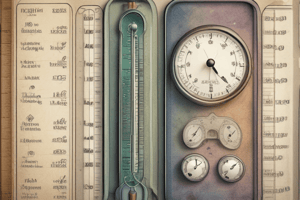Podcast
Questions and Answers
What is the absolute zero in Celsius?
What is the absolute zero in Celsius?
- -272.10 oC
- -273.10 oC
- -273.15 oC (correct)
- -272.15 oC
What happens to the temperature of a substance when heat energy flows into it?
What happens to the temperature of a substance when heat energy flows into it?
- It usually rises (correct)
- It remains constant
- It decreases
- It depends on the type of substance
What is the main difference between the Kelvin and Celsius scales?
What is the main difference between the Kelvin and Celsius scales?
- The Kelvin scale is used for lower temperatures.
- The Kelvin scale has its zero point at absolute zero. (correct)
- The Kelvin scale has a different division.
- The Kelvin scale is used for higher temperatures.
What is the relationship between the average kinetic energy and temperature of an ideal gas, liquids, and solids?
What is the relationship between the average kinetic energy and temperature of an ideal gas, liquids, and solids?
Why is temperature difficult to measure directly?
Why is temperature difficult to measure directly?
What is the relationship between the Kelvin and Celsius scales?
What is the relationship between the Kelvin and Celsius scales?
What is the Fahrenheit formula to convert Celsius to Fahrenheit?
What is the Fahrenheit formula to convert Celsius to Fahrenheit?
What physical property of a substance changes with temperature?
What physical property of a substance changes with temperature?
Which of the following is NOT a method of measuring temperature indirectly?
Which of the following is NOT a method of measuring temperature indirectly?
Why is the Kelvin scale considered an absolute temperature scale?
Why is the Kelvin scale considered an absolute temperature scale?
What is the scientific term for the study of producing and using very low temperatures?
What is the scientific term for the study of producing and using very low temperatures?
What is the field of study that deals with the effects of low temperatures on biological systems and medicine?
What is the field of study that deals with the effects of low temperatures on biological systems and medicine?
What is the primary area of focus in Cryogenics?
What is the primary area of focus in Cryogenics?
Which of the following is NOT related to the study of low temperatures?
Which of the following is NOT related to the study of low temperatures?
What is the term used to describe the science and technology of producing and using very low temperatures?
What is the term used to describe the science and technology of producing and using very low temperatures?
What is the primary material used in making a thermometer?
What is the primary material used in making a thermometer?
What is the common substance used to measure temperature in a glass thermometer?
What is the common substance used to measure temperature in a glass thermometer?
What is the purpose of a thermometer?
What is the purpose of a thermometer?
What type of thermometer is commonly used to measure temperature?
What type of thermometer is commonly used to measure temperature?
What is the common feature of a glass thermometer?
What is the common feature of a glass thermometer?
What is the term used to describe the application of cryogenic methods to destroy cells?
What is the term used to describe the application of cryogenic methods to destroy cells?
What is one of the advantages of cryosurgery?
What is one of the advantages of cryosurgery?
How can the volume of tissue destroyed be controlled during cryosurgery?
How can the volume of tissue destroyed be controlled during cryosurgery?
What is the main purpose of cryosurgery?
What is the main purpose of cryosurgery?
Who is the lecturer responsible for teaching about cryosurgery?
Who is the lecturer responsible for teaching about cryosurgery?
Flashcards are hidden until you start studying
Study Notes
Temperature and Heat Energy
- When heat energy flows into a substance, the temperature of the substance usually rises.
- The average kinetic energy (K.E.) of a substance is directly proportional to its temperature (in ideal gases, liquids, and solids).
Thermometry and Temperature Scales
- Temperature is difficult to measure directly, so it's usually measured indirectly by measuring physical properties that change with temperature.
- Examples of physical properties that change with temperature include:
- Volume (density) of most substances, which increases with temperature.
- Electrical resistance.
- Color.
- Emission of infrared radiation.
- The Fahrenheit scale (°F) is related to the Celsius scale (°C) by the equation: tF = tc + 32.
The Kelvin Scale
- The Kelvin scale (°K) is also known as the absolute scale.
- The Kelvin scale has the same divisions as the Celsius scale, but takes 0 °K as absolute zero, which is equivalent to -273.15 °C.
Measuring Temperature
- The most common way to measure temperature is using a glass thermometer containing mercury or alcohol.
- The glass thermometer is a common device used to measure temperature.
Cryogenics and Cryosurgery
- Cryogenics is the science and technology of producing and using very low temperatures.
- Cryobiology is the study of low-temperature effects in biology and medicine.
- Cryosurgery is the application of cryogenic methods to destroy cells, and is used to destroy tissue in a controlled manner.
- Advantages of cryosurgery include:
- Minimal bleeding in the destroyed area.
- The ability to control the volume of tissue destroyed by the temperature of the cryosurgical probe.
Studying That Suits You
Use AI to generate personalized quizzes and flashcards to suit your learning preferences.



